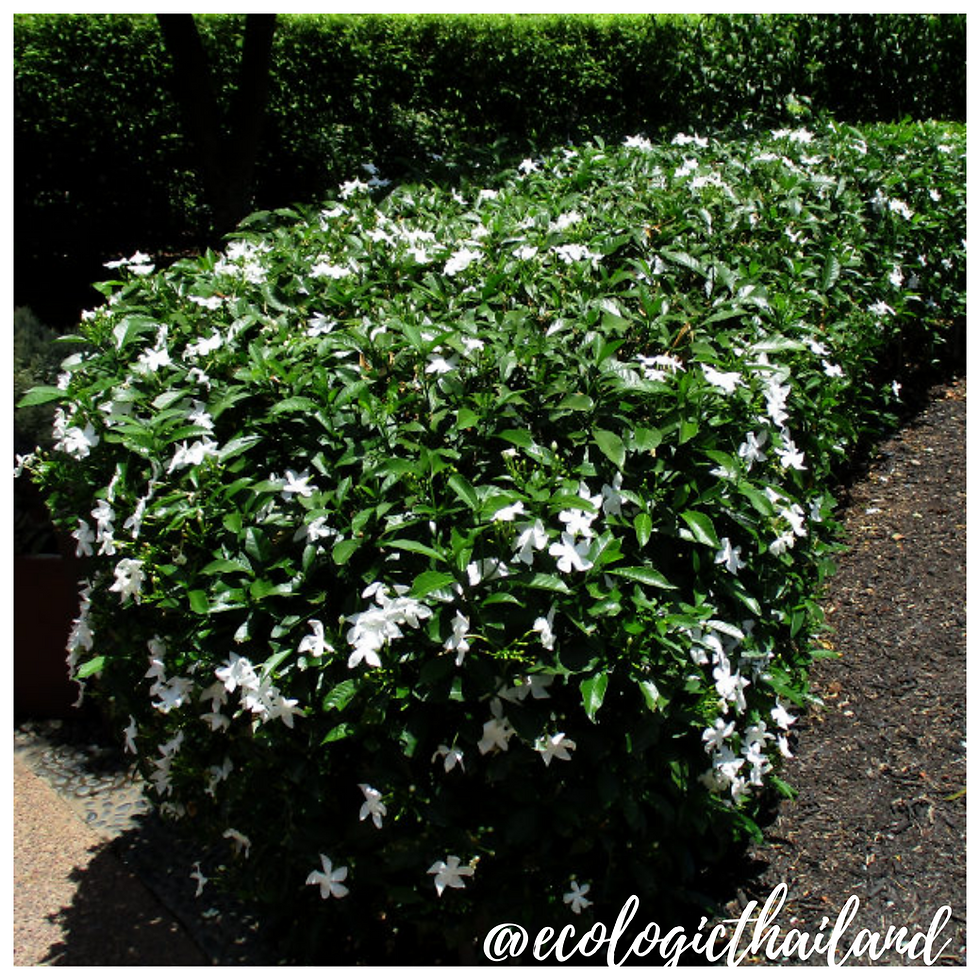Pandan
- Eco-Logic Resort
- Jan 7, 2021
- 3 min read
Bai Toey | ใบเตย | Pandanus amaryllifolius
Family: Pandanaceae - Genus: Pandanus

The pandan plants can be found in the area of the chicken and duck farm of the Thai Child Development Foundation.
There are two distinct Pandan plant shapes. If the plant is left undisturbed and the leaves are not harvested, it will develop into a small tree with large, long, and thin green leaves that can reach up to two meters in length.
If the leaves are continuously harvested, the plant will stay low to the ground forming a shrub-like appearance with smaller, narrow green leaves growing up to one meter in length.
The upright green leaves taper to a point at the tip, and when attached to their stems,
Pandan leaves resemble the top of a pineapple plant. Pandan leaves have a unique and distinct grassy aroma when first crushed that mellows out to a subtle, herbal, and floral aroma. When cooked, Pandan leaves have a nutty, almond, rose-like, and slightly sweet flavor, widely used for flavoring in the Thai kitchen.
The plant itself reproduces by suckers and off-shoots and will grow many aerial roots and can grow up to 1.5 meter high.
When harvesting pandan leaves, it is important to pick the older leaves at the bottom of the plant first. These are often dark green and contain the richest concentration of fragrance and taste.

THE PLANT
Pandanus are usually large trees with spiny leaves, well adapted to life along the beachfront.
However, this little Pandanus – the Edible Pandan – is a short and strappy species with soft spineless leaves.
Prized in Asian cookery, the Edible Pandan is often used to flavor rice dishes or as a wrap for steaming. Edible Pandan grows to a maximum of 2m, usually more like 1.5 meter.

THE LEAVES
Pandan is an upright, green plant with fan-shaped sprays of long, narrow, blade-like leaves and woody aerial roots.

THE FLOWERS
The plant is sterile, with flowers only growing very rarely.
CULINARY USES
Pandan is used extensively in Thai cooking as both a flavoring and coloring agent. The juice from the leaves is found in both sweet and savory dishes, and is used in a way to how Western cooking uses vanilla.
fter picking the fresh leaves, tie them in knots and use to flavour dishes (the leaves themselves are then discarded and not usually eaten). The resulting aroma and mouth-watering flavor from the foliage is unmistakable.
The leaves can also be steeped in coconut milk, which is then added to the dish.
Pandanus leaves are also frequently mixed with other herbs to make tea.
Pandan chicken, (Thai: ไก่ห่อใบเตย, kai ho bai toei), is a dish of chicken parts wrapped in pandan leaves and then fried.
NUTRITION
Pandan leaves are rich in essential oils, glycosides, and alkaloids, and also contain traces of tannin and isoprene esters.
TRADITIONAL MEDICINAL USE
NOTE: please take advice from a doctor if you are planning to use herbal medicine.
Pandanus is beneficial for the heart, lowers cholesterol levels, and is known as a pain reliever. The leaves are chewed for oral pain, and are used for easing stomach cramping. Pandanus also reduces fever and mucus congestion, and relieves indigestion and flatulence.
Pandanus leaves are beneficial for wounds when applicated external, and bathing in water with pandanus leaf juice eases sunburn.
Lastly, a pandan leaf folded under a pillow is said to induce a good night’s sleep.
INTO THE WILD: a down to earth experience

For guests and visitors to Paksong we organize weekly tours "The Edible Forest" and Foraging weekends: Into the Wild. We work with local guides to take you in the jungle of Paksong. After foraging, we will cook a meal with the ingredients, using bamboo together with you!
Come and join and learn about the abundance of food that nature gives us!
INTO THE WILD!


















Comments